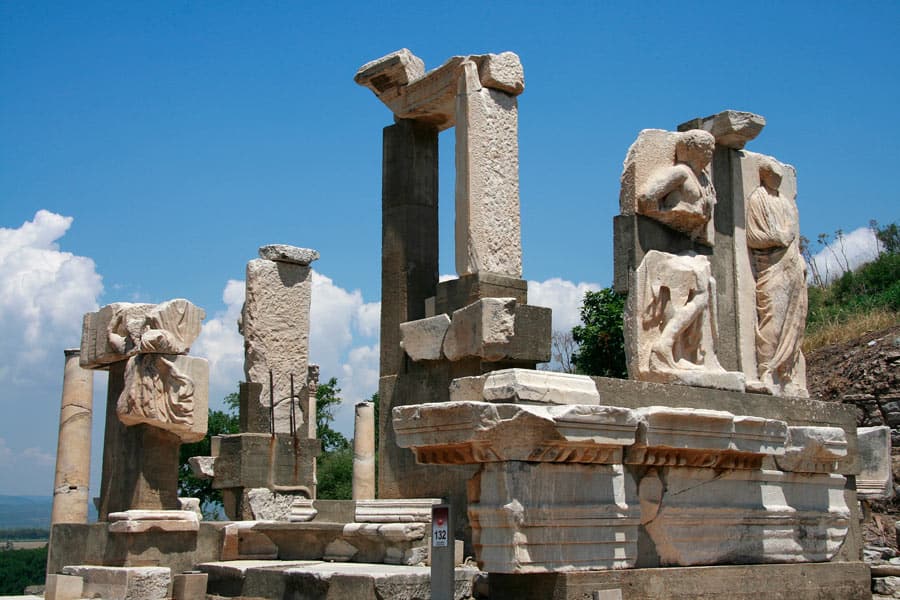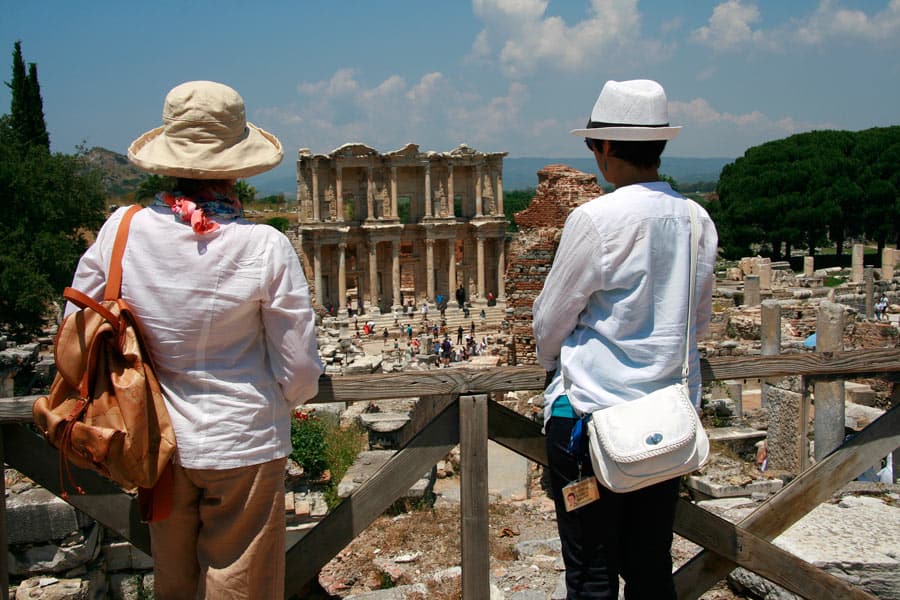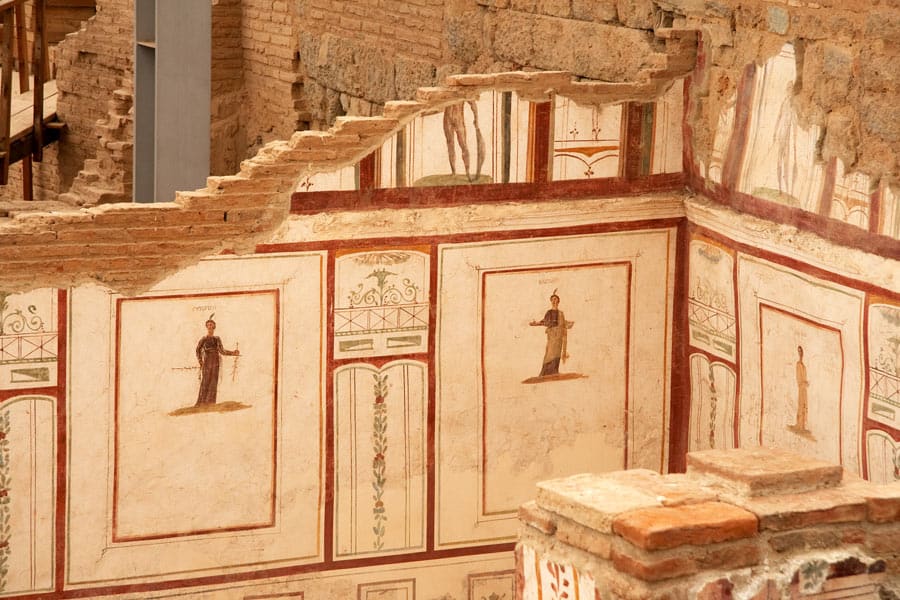Visiting Ephesus, Turkey: Tips on What to See and Do

This post may contain affiliate links. If you make a purchase through them, we may earn a small commission (at no cost to you).
Are you planning on visiting Ephesus? You’re in for a cultural treat!
We’ve just returned from our third visit to the Ephesus archaeological site.
Yes, we’d visited Ephesus before (once as part of an extensive trip to Turkey). But we couldn’t miss exploring it again!
It’s the ancient city in Turkey where breezes carry the imagined laughter and chatter of Romans bartering with shopkeepers among centuries-old marble stalls.
Where the façade of the famous Celsus Library – which once housed up to 15,000 scrolls – is more magnificent and grander in scale than what you see in photos.
Where blood-red poppies bloom among the ancient ruins…
It’s also believed the Virgin Mary lived out her later years in a small stone house in Ephesus.
So here’s our comprehensive guide on what to see in Ephesus, along with practical insider tips for visiting the ruins of Ephesus, Turkey.

Contents: Ephesus travel guide
How much time do you need in Ephesus?
Where is Ephesus?

Ephesus (or Efes in Turkish) is located near the western coast of Turkey in the province of Izmir, near the town of Selcuk.
It’s about a 30-minute drive from the port city of Kusadasi.
History of Ephesus
Before we get into the various Ephesus sights, it’s helpful to know a little about the city’s history.
Ephesus is a tale of two cultures.
It was originally established by the Greeks in the 11th century BC (some reports say the 10th century BC), but later fell under Roman rule in 129 BC.
This is when it entered its golden age.
It became the beating heart of the Roman province of Asia and one of the largest cities in the Mediterranean region. A hub of sophistication and culture, it was home to a quarter of a million people at its peak.
Many of the structures you see today are masterpieces of the Roman architects – from the Temple of Hadrian to the expansive theater and Library of Celsus (all discussed below).

Ephesus also holds a key role in Christian history.
It’s said that the Apostle John brought the Virgin Mary to Ephesus, where she spent the last years of her life. St. Paul also visited Ephesus in 53 AD.
In 262 AD, the Goths ravaged Ephesus. While attempts were made to breathe new life into the city, it never regained its original grandeur and magnificence, and by the 15th century, it was pretty well abandoned.
Fast forward to the mid-1800s.
Excavation of Ephesus began when John Turtle Wood, an English archaeologist working on behalf of the British Museum, searched for the Temple of Artemis, one of the Seven Wonders of the Ancient World.
Today, the ancient city of Ephesus is a UNESCO World Heritage Site. It’s one of the most well-preserved ancient cities in the modern world, echoing the glory of a bygone era.
And even though excavations continue, it’s estimated that less than 15% of the ancient city has been uncovered to date.

How much time to spend in Ephesus today?
You don’t need more than one day in Ephesus.
You can actually see the highlights in a couple of hours. But we wouldn’t recommend this as you’d be rushing.
Three hours is a more comfortable length of time to spend at the actual archaeological site, especially if you tour the terrace houses.
If you add the House of the Virgin Mary, Ephesus Museum and lunch (all covered below) to your Ephesus one-day itinerary, this will take at least a couple more hours.
What to see in Ephesus in one day

There are two main entrances, both with ticket booths.
The following are the main sites you see when visiting Ephesus. We’ve organized them in order, starting from the Upper Entrance Gate (south entrance).
1) Baths of Varius
Standing near the entrance to Upper Ephesus, the arched ruins of the Baths of Varius date back to the 2nd century AD.
Built with finely cut marble blocks, they comprise a frigidarium, tepidarium and caldarium, representing cold, warm and hot baths, respectively. A mosaic passageway over 130 feet long was added in the 5th century.
They offer a window into Roman-era leisure and hygiene practices.
Only the affluent could afford private baths, so most of the city’s residents frequented public baths like this bathhouse. Typically, men and women bathed separately at different times of the day, where they’d enjoy massage treatments, gossip and learn the daily news.
2) Curetes Street

Known as the Marble Road, Curetes Street is a mile-long marble street connecting Upper Ephesus with the lower city.
Lined with columns, shops, statues, fountains, terraced houses and monuments, it was a vibrant hub and ceremonial route in honor of the Greek Goddess Artemis.
When you walk it, you’ll be walking along the same path that Antony and Cleopatra once did!
3) Nike Goddess

Right at the top of Curetes Street in Ephesus, you’ll see a marble relief of Nike, the Greek goddess of victory, dating back to the 1st/2nd century AD.
This beautifully carved piece once decorated the arch over the Hercules Gate (which was the official entrance to Curetes Street).
Now, if looking at this winged Nike goddess makes you think of the Nike running shoes brand, you’re spot on. Phil Knight, the brains behind the Nike brand, deliberately picked the name Nike, drawing inspiration from the goddess of victory herself.
4) The Nymphaeum Traiani

This monumental fountain, with a magnificently carved marble façade, was built between 102 and 114 AD. It was donated by Tiberius Claudius Aristion and his wife in honor of Emperor Trajan and the goddess Artemis.
The fountain served as a public water supply.
5) Alytarchs’ Stoa (Hall)

As you go down Curetes Street, you’ll come to the so-called Alytarch’s Stoa on the left side. It was a large hall, about 174 feet long and perhaps 16 feet deep, with a row of shops and workshops behind it.
The floor was made of mosaic tiles, adorned with intricate geometric and floral designs, sections of which you can see today.
6) Latrine

Oh, and what do we see here? It’s a public latrine!
Not everyone in Ephesus was rich enough to have their own toilet at home. So for a small fee, they could use the public latrine.
These toilets were ingeniously built right over a running water channel. Three sides of the latrine were lined with marble benches with holes cut out to serve as toilet seats.
There were 48 toilets in this latrine, but only a dozen or so can be seen today.
7) Terrace Houses at Ephesus

For an additional small fee, separate tickets allow you to detour off Curetes Street to see what are known as the “terrace houses,” where wealthy Roman families once lived.
They lived lavishly!
The Roman elite enjoyed two-story residences, boasting interior courtyards, mosaic tile floors and splendidly painted wall frescoes.

They even had central heating! Innovative clay pipe systems ran beneath the floors, circulating hot air for heating – a luxury in the ancient world.
Archaeologists today are still restoring these houses, and you can watch as they piece together the largest jigsaw puzzle in the world – recreating the rooms from marble pieces of floors and walls.

As these houses are one of the most interesting things to see in Ephesus, we highly recommend that you visit them when touring Ephesus.
8) Temple of Hadrian, Ephesus

The Temple of Hadrian – more monument than temple – sits across the street from the Terrace Houses.
Built in the 2nd century AD, it honors the Roman Emperor Hadrian (considered one of the “Five Good Emperors” of ancient Rome).
The front section makes it one of the city’s most graceful structures – four stately Corinthian columns on the temple’s façade hold up a beautifully curved arch.
9) Library of Celsus

The most striking structure in Ephesus is the ornate façade of the Celsus Library.
No matter that we’d gaped at it on two previous occasions. It was just as awe-inspiring to see it again on our third visit to ancient Ephesus!
It’s something you absolutely must see in Ephesus. (It’s actually hard to miss, so don’t worry about that.)
The library was built between 110 and 135 AD as a tribute to a popular book-loving Roman senator known as Celsus. It was the third biggest library in the ancient world, only outshone by those in Alexandria and Pergamum.
It had two floors, and a gap between the inner and outer walls cleverly protected the prized scrolls from temperature and humidity swings.

Today, visitors clamber up the steps to have their photos taken beneath copies of the four female statues that stand on the lower floor representing the Four Virtues: Sophia (wisdom), Arete (excellence), Episteme (knowledge) and Ennoia (thought).
10) Prostitute’s footprint and brothel

If you visit Ephesus with a guide, they’ll no doubt point out the footprint embedded in a slab of marble on Curetes Street.
It’s a prostitute’s left footprint and it points in the direction of the brothel.
11) Ancient Theater of Ephesus

One of the largest Roman theaters, the great theater at Ephesus is splendidly preserved.
Fun fact: This theater is not an amphitheater as it’s only a half oval shape. An amphitheater is shaped in a full circle or oval, so it’s like a stadium.
Built in the Hellenistic period and expanded by the Romans, it could seat up to 25,000 spectators.
The acoustics are excellent – we tested the sound by shouting and listening to the echoes.
Elton John, Sting, Ray Charles, Bryan Adams and Luciano Pavarotti have all performed modern-day concerts performed in the Ephesus theater.
12) Agora (Marketplace)
Surrounded by colonnades, the Agora at Ephesus was the city’s main marketplace and social center.
Remnants – scattered columns and the bases of once-grand buildings that lined the agora – can still be seen today.
Other Ephesus attractions
House of the Virgin Mary

There are more things to do in Ephesus than visiting the actual site.
Be sure to also carve out some time for The House of the Virgin Mary.
It’s nestled on Mt. Koressos, about a 15-minute drive up a steep winding road, past pomegranate and olive groves.
It’s believed that this small stone cottage was where the Virgin Mary journeyed, accompanied by Saint John, to spend the last years of her life.
Today, it’s an important pilgrimage site and has been visited by no less than three popes: Pope Paul VI in 1967, Pope John Paul II in 1979 and Pope Benedict XVI in 2006.
Regardless of your beliefs, the shrine is a peaceful and poignant place. Visitors tend to whisper, and for a few moments at least, we felt far removed from the hustle and bustle of the outside world.
Note that there’s no direct public transport to here, so plan your trip accordingly.
You can take a taxi from Ephesus. Many Ephesus tours also combine a visit to the Virgin Mary’s House.
Ephesus Archaeological Museum

Tucked away near the Basilica of St. John in Selcuk, Turkey, you’ll find this small museum.
The Ephesus Museum safeguards artifacts excavated from the Ephesus ruins after 1923.
Before this time, art treasures unearthed between 1867 and 1905 found their way to the British Museum, while those from 1905 to1923 were transported to Vienna.
Recognizing the immeasurable value of these pieces, the Turkish Republic put a stop to the export of historical pieces after 1923.
What you see in the Ephesus Archaeological Museum today are Hellenistic and Roman statues, coins, jewelry, carved reliefs and artifacts dup up post-1923.
The two life-size marble statues of Artemis (Goddess of fertility) are housed here.
Particularly intriguing are the round, egg-shaped embellishments that adorn the lower part of each statue’s chest. Though many people mistake them for breasts, they more likely symbolize bull testicles or gourds, both recognized fertility symbols in Asia.
Whatever the symbolism, don’t miss these statues – they’re the most spectacular exhibits in the museum.
Practical Ephesus information (Hours and cost)
Ephesus opening hours
The Ephesus archaeological site is open to visitors every day of the year.
Opening hours are generally between 8:00 am and 8:00 pm. (Check the website for exact opening hours.)
Ticket sales usually end at 7:00 pm in the evening. But we don’t recommend you leave it until the end of the day to visit, as then you’d be racing around to cram everything in!
Ephesus entrance fee
Ephesus tickets cost 40 Euros (or approximately $43 USD per person).
There’s an additional cost of 15 Euros (about $16 USD) p.p. to see the Terrace Houses (which we recommend).
Official website for the Ephesus archaeological site
See this site.
Tip: Turkey Museum Pass
If you plan on visiting independently several museums and iconic attractions on your visit to Turkey, then it’s worth getting a Turkey Museum Pass (Museum Pass Turkiye).
This pass allows you to visit more than 350 museums, archaeological sites and other attractions (like the Topkapi Palace in Istanbul – but excluding the Dolmabahce Palace) throughout Turkey.
It’s valid for 15 days starting from your first museum visit and costs 165 Euros (about $177 USD).
The pass is valid for entry to Ephesus.
How to visit Ephesus
Visiting Ephesus on your own
You can easily visit Ephesus on your own from Kusadasi or Selcuk.
But the price for a guided tour is not much more than the Ephesus entrance cost. And it includes transportation. Not to mention that a tour includes a guide to make sense of all the sights!
So it’s a no-brainer to book a tour of Ephesus.
Visiting Ephesus on a tour from Kusadasi
See this top-rated small-group tour from Kusadasi, which has a maximum group size of 10.
Visiting Ephesus on a day trip from Bodrum
One time we visited the archaeological site was on an Ephesus day tour from Bodrum.
We booked a private tour with Vanguard Travel Services, one of Turkey’s top travel agencies. Throughout our trip, they seamlessly arranged our airport/hotel transfers and tours.
Alternatively, see this full-day tour, which includes lunch.
The 2-hour scenic drive from Bodrum to Ephesus winds past mountains and rolling hills, blanketed with forests of pine and wild olive trees.
Visiting Ephesus from a cruise ship

Kusadasi is a popular port-of-call on Mediterranean cruise itineraries. And Ephesus shore excursions are a highlight of such cruises.
You can book a shore excursion through your cruise ship.
Usually, cruise ship excursions are more expensive than locally-booked tours. But they do guarantee that the ship will wait for your tour to return (or they’ll transfer you to the next port at their cost, in the rare case your return is seriously delayed).
If your cruise offers a special evening event at Ephesus, be sure you sign up for this!
On our recent Windstar cruise on the Star Pride from Istanbul, the ship hosted a complimentary moonlight dinner in front of the Celsus Library, accompanied by live classical music. Magical!
As an alternative to a daytime cruise ship excursion, if your ship is in port for the day, you might want to look at this private tour for cruise ship guests.
It will be just you and your partner or group in the Mercedes van, and you’ll likely leave the port for your Ephesus excursion well before the cruise ship buses depart – so you can beat the crowds.
Tips for visiting Ephesus



Start at the Upper Entrance Gate
While Ephesus had several entrance gates in ancient times, there are two main gates today.
The Upper Entrance Gate is the south entrance. This is where tour buses typically drop you off. (It has a small parking lot and toilets.)
From here, you walk slightly downhill through the ancient city.
The Lower Entrance Gate at the northern end is the main entrance. It has a large parking area, restrooms, souvenir shops, cafés and so on.
It’s usually more crowded at the Lower Entrance Gate, so if you have a choice, we’d suggest you start at the upper Ephesus entrance.
Go early in the morning
The best time to visit Ephesus is in the morning, just after the site has opened.
You want to try and get ahead of all the cruise day-trippers, if you can.
Also, there’s not much shade and it gets hot – the summer months of June, July and August can be scorching. So a morning visit is cooler.
The other option is to go mid-afternoon, when the crowds typically start to thin out.
Wear proper sandals or shoes
As for what to wear at Ephesus, our most important tip is to wear sturdy walking shoes or good travel sandals.
Made of marble, Curetes Street can be quite slippery in places (especially if it’s been raining). Flip-flops won’t give you sufficient traction and shoes with heels could be a tripping hazard.
Where to eat in Ephesus

Knowing we were hot and hungry after exploring Ephesus on one morning visit, our private guide suggested lunch at Bizim Ev Hanimeli.
From its humble start in 1992 as a simple tea garden, this wonderful restaurant has grown in scale as “Mama’s” reputation in the kitchen has spread – earning it rave reviews as one of the best restaurants in Selcuk.
Cansu Tucker, the daughter of the owner, has since created a cookbook that lets you recreate her Turkish dishes back home.
We helped ourselves to a buffet spread of some 30 different dishes – from yogurt-and-cucumber spreads, to stuffed zucchini blossoms, dolmades and meatballs, to Mama’s famous creamy grated carrot dish.

All dishes are made fresh, earlier in the day, under Mama’s supervision.
Seated outside in the tree-shaded garden by a tinkling fountain, we ate in companionable silence – and reflected on the marvel that is Ephesus.
Where to stay in Ephesus?
The town of Selcuk is the best place to stay near Ephesus.
The top-rated boutique Akanthus Hotel Ephesus boasts a welcome pool and garden. Rooms feature hardwood floors and Turkish rugs, along with conveniences like air-conditioning and flat-screen TVs.
If you’d like to stay in Kusadasi, the beachfront Charisma De Luxe Hotel is a 5-star hotel with an infinity pool, as well as a heated indoor pool.
Frequently asked questions about Ephesus
Is Ephesus worth visiting?

Ephesus is a must-visit for history enthusiasts and culture buffs.
Once an ancient Greek city, now in modern-day Turkey, it boasts impressive ruins, including the famed Library of Celsus, terraced houses and remains of the Temple of Artemis. These ruins offer a glimpse into the Greek and Roman civilizations that once thrived there.
So, yes, it’s highly recommended!
Who built Ephesus?
According to legend, Ephesus was founded in the 11th century BC by the Ionian prince Androclos.
Searching for a new Greek settlement, he consulted the Oracle of Delphi, who cryptically mentioned a boar and a fish as guides.
The prophecy came true when a fish, which Androclos was frying over a fire, jumped into the bushes, sparking a flame that startled a wild boar. Recognizing this as the oracle’s sign, Androclos established the new city of Ephesus there.
Another tale says that Amazons (female warriors) founded Ephesus, naming it after their queen, Ephesia.
What happened to the Temple of Artemis?

The famed Temple of Artemis (also known as the Temple of Diana) was built by Croesus, King of Lydia, near Ephesus, around 550 BC.
It consisted of 127 Ionic-styled columns, each 60 feet high.
The temple was admired for its size (over 350 by 180 feet) and beauty, and it became one of the Seven Wonders of the Ancient World.
Sadly, it suffered many mishaps over the centuries.
To begin with, a man named Herostratus set the temple on fire in 356 BC. After it was rebuilt by the Ephesians, it was grander than before. But the temple was again destroyed when the Goths raided Asia Minor.
As Christianity spread throughout the Roman Empire, many pagan temples lost their significance. The Temple of Artemis was no exception. Its remains were repurposed, and its stones were used in constructing other buildings.
Only a single column stands today at the site in modern Turkey as a reminder of its past grandeur, reconstructed from salvaged pieces. The rest of the temple’s remains are scattered, with some artifacts housed in museums.
Some popular Ephesus tours
You might like these:
- Top-rated private tour: Unearth the wonders of Ephesus with a well-educated professional as your expert local guide on this 4- to 6-hour private tour. You’ll also see the House of the Virgin Mary. (Roundtrip cruise port or hotel transfers are included.)
- Small-group tour: This in-depth, 5-star-rated tour (4 to 6 hours) has a maximum group size of 10. It takes in all the key Ephesus attractions plus the House of the Virgin Mary. It includes return transportation from the Kusadasi cruise port and Kusadasi hotels.
- Ephesus tour and cooking class: Explore the ancient ruins of Ephesus then enjoy a cooking class with locals at a nearby village on this ancient city and cooking experience.
- Ephesus and e-biking tour: You’ll walk the streets of Ephesus. Then you’ll be transferred to the village of Cemlik, where you’ll hop on your e-bike for a guided bicycle tour of surrounding villages. You’ll also sample pancakes and tea for a lunch snack on this 6- to 7-hour Ephesus and e-biking experience.
That wraps up our Ephesus travel guide!
Visit once. Visit three times. No matter how often you visit, Ephesus never loses its magic!
Ephesus captivates every traveler who visits with its rich history and stunning ruins. From the architectural marvel of the Celsus Library to the peaceful House of the Virgin Mary, it’s a splendid journey through time.
Opting for a guided Ephesus tour only enhances the experience, ensuring you don’t miss any of its hidden gems.
See our other travel guides on Turkey
- The Perfect Itinerary for 2 Weeks in Turkey
- Best Boutique Hotels in Istanbul
- 7 Top Istanbul Hammams for Luxury Lovers
- Hot-Air Ballooning in Cappadocia
- Argos in Cappadocia: Luxury Cave Hotel
- Esbelli Evi Review: Fairytale Charm in Cappadocia!
- Macakizi Hotel: Glam Beach Hotel in Bodrum
- Casa Dell’Arte: Arty Boutique Hotel in Bodrum
Like this post on what you must see in Ephesus? Then pin it!


Our top travel tips and resources
General trip planning: TripAdvisor is a helpful starting point, offering loads of user reviews on hotels, restaurants and things to do.
Hotels: Booking.com is our go-to for scoring a “wow” hotel – or at least a decent one – often at lower rates than the hotel’s own website. We especially like Booking’s flexible cancellation policy! (You may prefer Expedia for booking hotels in the U.S. or Mexico.)
Vacation homes, condos and rentals: We prefer and use Vrbo (Vacation Rentals by Owner).
Flights: For the cheapest flights, search on Google Flights or Expedia. (Just be aware Expedia tickets are often non-refundable. If you want more flexibility, it’s usually worth booking directly with the airline, even if it costs a bit more.)
Airport lounge access: We love (and have) Priority Pass for comfy lounge seats, free snacks and drinks, complimentary WiFi and sometimes even showers and spa services!
Tours: For the best local food, walking and other guided tours, plus skip-the-line tickets to attractions, check out Viator (a TripAdvisor company) and GetYourGuide.
Car rental: Renting a car is often a great way to explore off the beaten path. Discover Cars searches car rental companies so you get the lowest rates.
eSIMS: Stay connected affordably with Airalo eSIMS covering 200+ countries and trusted by 10 million+ users, including us! (No more huge roaming bills!)
Travel insurance: SafetyWing is designed for frequent travelers, long-term adventurers and digital nomads. It covers medical expenses, lost checked luggage, trip interruption and more. We also have and recommend Medjet for global air medical transportation.
Travel gear: See our travel shop to find the best luggage, accessories and other travel gear. (We suggest these comfy travel sandals for city walking, the beach and kicking about.)
Need more help planning your trip? Check out our travel tips and resources guide for airline booking tips, ways to save money, how to find great hotels and other crazy useful trip planning info.
If you make a booking or purchase through our site, we may earn a small commission (at no cost to you). Thanks!
Photo credits: © Janice and George Mucalov, SandInMySuitcase (except 25 and 26, courtesy Bizim Ev Hanimeli, and 1, 17, 19, 20, 28)
About the authors

